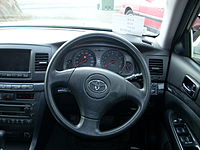Toyota Mark II Blit
This article relies largely or entirely on a single source. (February 2019) |
| Toyota Mark II Blit (X110) | |
|---|---|
 Toyota Mark II Blit 2.5iR-V (JZX110W, Japan) | |
| Overview | |
| Manufacturer | Toyota |
| Production | January 2002 – June 2007 |
| Assembly | Japan: Toyota City, Aichi (Motomachi plant)[1] |
| Body and chassis | |
| Class | Mid-size car |
| Body style | 5-door station wagon |
| Layout | |
| Related | |
| Powertrain | |
| Engine | |
| Transmission | |
| Dimensions | |
| Wheelbase | 2,780 mm (109.4 in) |
| Length | 4,775 mm (188.0 in) |
| Width | 1,760 mm (69.3 in) |
| Height |
|
| Kerb weight | 1,470–1,620 kg (3,241–3,571 lb) |
| Chronology | |
| Predecessor | Toyota Mark II Qualis |
| Successor | |
The Toyota Mark II Blit (Japanese: トヨタ・マークIIブリット, Toyota Māku II Buritto) is a mid-size station wagon manufactured by the Japanese automaker Toyota. It is the replacement of the Mark II Qualis and shared a platform with the X110 series Mark II rear-wheel drive sedan, while the Mark II Qualis is a rebadged XV20 series Camry Gracia wagon, with front-wheel drive layout. The Mark II Blit was introduced in January 2002 and ended production in June 2007 due to consolidation efforts. The car remained in production until three years after the Mark X came out, which replaced all of Toyota's X-body sedans, the Verossa, which in turn is a successor to the Chaser and the Cresta, and the Mark II. Toyota's official Mark II Blit successor is the front-wheel drive minivan, the Mark X ZiO, from September 2007. The Mark II Blit marked the return to the Mark II platform with rear-wheel drive layout with optional four-wheel drive and not a wagon version of the front-wheel drive Camry. The car was given a minor facelift in December 2004, including changes to the headlamps, grille and taillamps, which are replaced with LED units. The Mark II Blit uses six-cylinder engines with an optional turbocharger that was discontinued in May 2006, as a result of Japan's emission standards in 2005. The engines used were the 2.0 L 1G-FE, 2.5 L 1JZ-FSE, 2.5 L 1JZ-GE, and 2.5 L single-turbocharged 1JZ-GTE.
The name "Blit" is taken from German word "blitz", meaning "lightning".[2]
Trim levels
[edit]The Mark II Blit was offered in several trim levels. It is identical to the Mark II sedan's trim levels, although the Mark II Blit wasn't offered in the Grande trim level:[3]
| Trim levels | 2.5iR-V | 2.5iR-S Four | 2.5iR-S | 2.0iR Four | 2.0iR |
|---|---|---|---|---|---|
| Model code | JZX110W-AWPVZ | JZX115W-AWPSF | JZX110W-AWASH | GX115W-AWPSK | GX110W-AWPSK |
| Kerb weight | 1,620 kg (3,571 lb) | 1,610 kg (3,549 lb) | 1,570 kg (3,461 lb) | 1,550 kg (3,417 lb) | 1,470 kg (3,241 lb) |
| Engine | 1JZ-GTE | 1JZ-GE | 1JZ-FSE | 1G-FE | |
| Power output | 280 PS (206 kW; 276 hp) at 6,200 rpm | 196 PS (144 kW; 193 hp) at 6,000 rpm | 200 PS (147 kW; 197 hp) at 6,000 rpm | 160 PS (118 kW; 158 hp) at 6,200 rpm | |
Gallery
[edit]- Toyota Mark II Blit 2.5iR-V (JZX110W, Japan)
- Interior
References
[edit]- ^ "General Status of Plants in Japan | Motomachi Plant". Toyota. 2012. Retrieved 15 April 2020.
- ^ "Data: Origin of a car's name". Toyota. 2012. Retrieved 14 April 2020.
- ^ "Vehicle Lineage - In-depth Vehicle Information, Specification". Toyota. 2012. Retrieved 23 April 2018.


 French
French Deutsch
Deutsch
